Onward north
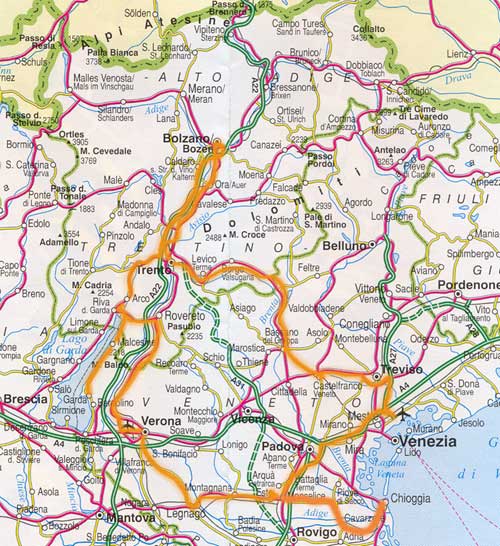
We picked up our car at Marco Polo Airport from the very reasonably priced (and reliable) company we always use Italy by Car
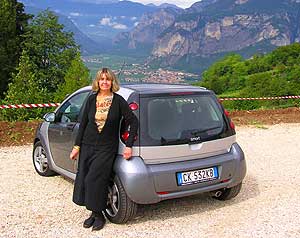
It was a SMART car and it proved itself to
be remarkably “smart” not only because of its size but also because it used up remarkably
little fuel. (The cost of gas for our entire 10 days of driving amounted to about $100.)
We drove along the smaller roads through Veneto (intending
to travel north to the Austrian border,) stopping for the night at Bassano del Grappa -
renowned for its centuries-old production of grappa. 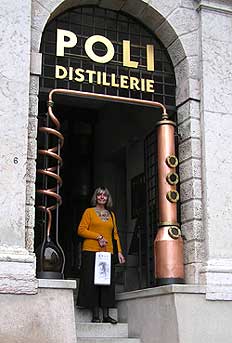 According
to Jacopo Poli, whose 1898 distillery (still run by his descendents) we toured,
According
to Jacopo Poli, whose 1898 distillery (still run by his descendents) we toured,
“To distill good Grappa is easy: One only needs fresh grape-pomace and one hundred
years of experience.”

The distillery looked as I would imagine the laboratory
of an ancient alchemist to look – copper, brass, stone and glass everywhere along with ancient
manuscripts; it had a magic about it – and it was beautiful.
Unfortunately it began to rain when we arrived in Bassano; otherwise we would have enjoyed the town more, especially since it was the weekend of “La Ballata del Millennio” - a festival re-enacting scenes from local history, dating as far back as the founding of the town in 1259 and including a medieval procession, the 1796 arrival of Napoleon, scenes from World War I and the 1944 Resistance fighting during World War II.
Sadly, it was raining so hard that even though the locals who had worked hard on their sets and costumes tried to go ahead with the performances, the audience ran for cover. By next morning the weather had cleared and we had a sense of how lovely the town really is; we might have lingered had we not been intending to explore the area further north.
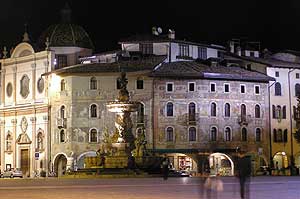 Our
destination that day was Trento, the capital of the region of Trentino-South Tyrol (in
Italian: Trentino-Alto Adige, in German: Trentino-Südtirol, in Ladin, the local dialect,
Trentino-Südtirol) - an autonomous region in northern Italy consisting of two distinct areas,
the Italian-speaking Trento and the largely German-speaking South Tyrol. The region was part of
Austria-Hungary until its annexation by Italy in 1919. Between 1919 and 1947, it was known
as Venezia Tridentina.
Our
destination that day was Trento, the capital of the region of Trentino-South Tyrol (in
Italian: Trentino-Alto Adige, in German: Trentino-Südtirol, in Ladin, the local dialect,
Trentino-Südtirol) - an autonomous region in northern Italy consisting of two distinct areas,
the Italian-speaking Trento and the largely German-speaking South Tyrol. The region was part of
Austria-Hungary until its annexation by Italy in 1919. Between 1919 and 1947, it was known
as Venezia Tridentina.
Thanks to our Lonely Planet (the guide book we always carry with us) we found a hotel we liked (Hotel Venezia) on the central square of the old town and decided to stay two nights.

 We
spent some time in the square called Piazza del Duomo which is adorned by the "Fontana del
Nettuno" (Fountain of Neptune), and surrounded by buildings of noble character. The southern
side is flanked by the "Duomo" (cathedral); To the east is the twelfth-century "Palazzo
Pretorio", a building with mullioned windows which houses the diocesan museum. This is followed
by the tower "Torre Civica", situated to the north-east of the two Cazuffi houses, decorated
by frescoes of the artist Fogliolino and by a small fountain, "Fontana dell'Aquila.
We
spent some time in the square called Piazza del Duomo which is adorned by the "Fontana del
Nettuno" (Fountain of Neptune), and surrounded by buildings of noble character. The southern
side is flanked by the "Duomo" (cathedral); To the east is the twelfth-century "Palazzo
Pretorio", a building with mullioned windows which houses the diocesan museum. This is followed
by the tower "Torre Civica", situated to the north-east of the two Cazuffi houses, decorated
by frescoes of the artist Fogliolino and by a small fountain, "Fontana dell'Aquila.
It was never crowded and had a good feel. At one point we heard wonderful music and walked across
the square to find two musicians, one with a guitar and the other with glasses filled with varying
amounts of water. We listened for a long time and bought their CD as a reminder of this lovely
experience.
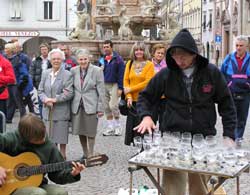
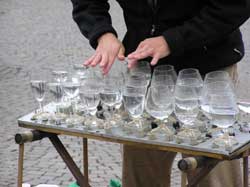
We walked the narrow alleys, saw many ancient churches and Roman ruins and found our way to the
cable car that takes one up to Monte
Bondone to get our first taste of the Dolomites that stretch across Trentino-Alto Adige into
the Veneto. It was closed but due to open again at 6am the next morning so, we got up early on
our day of departure to take the ride up and enjoy a hike on one of the less demanding of the
mountain trails – one that took us past many lush vineyards. As we rode up the sun began
to shine making this, our first walk in the Italian Alps, a pleasant one.
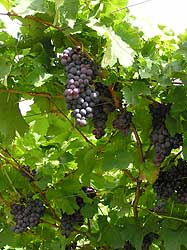
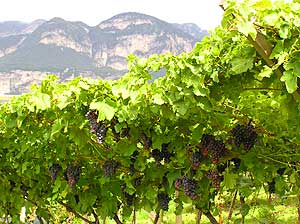
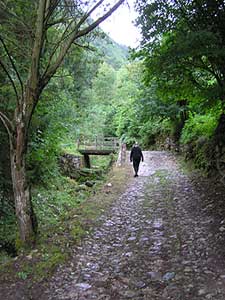
We headed back down to the town and were on the road by mid morning, heading to Bolzano. Enroute, we stopped at a couple of villages. The first, Faedo, was near Trento. We had turned off the main road and up into the hills covered with vineyards in search of a winery and, by chance, came across this tiny hamlet. In the time we spent in Faedo we saw only one person – a woman walking briskly up the gravel road that wound through the town. I followed her for a while; then, turned down a laneway and walked by the backs of a few small houses, looking at the colourful flowers and the remaining crops in the adjacent fields. Before leaving, we lingered in front of a tiny church called Chiesa di S. Agata – an old stone church that had an ancient look about it and stood at the entrance to the town on a piece of land from which the view was remarkably peaceful; then, we went to the other side of the road where outside a more modern church stood a war memorial erected by the US in memory of those who had died in this village during World War II. (This was the first of many reminders of the most recent wartime history in this region that now seemed so remote, quiet and peaceful.)
I wanted to stay longer (maybe even for the night) but, as George rightly pointed out, there seemed to be nowhere to sleep or even eat and we had already toured the village; so, we returned to the main road to Bolzano near the Austrian border.
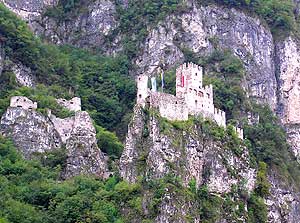 Our
next stop was a village, Egna/Newmarkt, in the shadows of a castle we spotted from the
road.
Our
next stop was a village, Egna/Newmarkt, in the shadows of a castle we spotted from the
road.
There are many castles along the valley walls but this one is perched so precariously on a cliff in the Dolomites above the town that it caught our attention. It seemed impossible to scale although flags waved from its tower. When we wandered the town, we never did find a path leading up to it and we left wondering how one would reach it. However, we did note a few signs indicating that this is a major rock climbing area; so, that may be a clue.
We arrived mid-afternoon in Bolzano (aka Bozen), found (with difficulty) a place to park, and walked in the direction of the tourist office. We passed a huge tent from which we heard distinctly Germanic music and stopped to listen for a while. It was pleasant, the sun was shinning; so, the initial impression of Bolzano was good. However, we quickly became uneasy, realizing that this place had a big city feel and that it was far more Austrian than Italian - we were not quite prepared for that. We did find an excellent place to stay. Called Gasthof Schwarze Katz/Albergo Gatto Nero, the sign featured a cat and had the feel of a rural "zimmer frei" complete with a pleasant German (only) speaking hostess who looked the "frau" part. It was well located only a 10 minute walk from the old centre of the city and just 50 metres from the cable car that travelled 1220 metres up to the alpine (skiing/biking/hiking) resort towns in the alps.
We spent the remainder of the day touring the small historic centre and then sought out a place for dinner trying to ignore the feeling that there were too many people, the scene was too modern and the food too heavy and not at all Italian.
 In the Dolomites above the city, it is said, lies the legendary realm of Laurin, the dwarf king.
His enchanted garden glows an unearthly red at twilight. So, early the next morning we took the
Funivia del Renon (cable car) into the Alps with high expectations. The ride up to Oberbozen
was pleasant (except for the crowds of German-speaking tourists) as was the ride on the old train
car
In the Dolomites above the city, it is said, lies the legendary realm of Laurin, the dwarf king.
His enchanted garden glows an unearthly red at twilight. So, early the next morning we took the
Funivia del Renon (cable car) into the Alps with high expectations. The ride up to Oberbozen
was pleasant (except for the crowds of German-speaking tourists) as was the ride on the old train
car 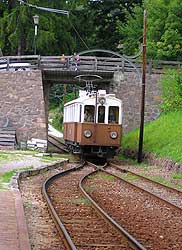 that
took us by some remarkable panoramic views and stopped, finally, at a rustic station from which
we walked into a small village centre of Kolbenstein and chose a hiking trail to the "Pyramids".
that
took us by some remarkable panoramic views and stopped, finally, at a rustic station from which
we walked into a small village centre of Kolbenstein and chose a hiking trail to the "Pyramids".
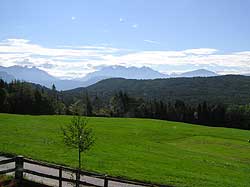 We
walked through forested areas, got lost a couple of times, searched for colourful mushrooms, and
did some climbing. It was enjoyable but not what we had expected; granted our expectations were
high.
We
walked through forested areas, got lost a couple of times, searched for colourful mushrooms, and
did some climbing. It was enjoyable but not what we had expected; granted our expectations were
high.
That evening we walked back into Bolzano's historic
centre and this time admitted to each other that we really didn’t like the place, that we
no longer wanted to cross the border into Austria and that what we really wanted was to get back
to the Italy we knew – and, certainly, out of this city.
So, we left Bolzano early the next morning with no
feelings of wanting to return and drove south, intending to get back into Tuscany - a 8 hour drive.
But we never did get back to Tuscany!
We had started off with a determination to drive as quickly as we could back into familiar territory. But, by late morning when we stopped at the medieval village of Arco, we were beginning to feel happier. The sun was warm; this town, with its cobblestone streets and ancient piazza felt ancient and lively - and the restaurants featured Italian cuisine. We had the sense that we were back in time - and back in Italy.
No longer in such a rush, we wandered and, eventually
walked up the long stone staircase that winds up through olive groves to the 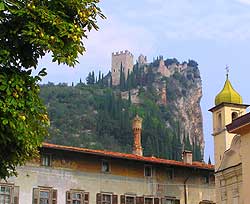 12th
century castle (Castello Di Arco) that overlooks the village. It was a long climb that provided
many spectacular views of the village below; so, by the time we had climbed down we were wondering
whether to stop there for lunch or, perhaps, even for the night. But we decided that, first, we’d
make the short drive to Riva
Del Garda on northern edge of Lago di Garda. We were not expecting to be enchanted by this
place as our Lonely Planet had emphasized how it attracts “bus and car loads”
of German and Austrian tourists and how it had been part of Habsburg Austria until it was incorporated
into Italy and how it was annexed by Nazi Germany in the closing years of WWII.
12th
century castle (Castello Di Arco) that overlooks the village. It was a long climb that provided
many spectacular views of the village below; so, by the time we had climbed down we were wondering
whether to stop there for lunch or, perhaps, even for the night. But we decided that, first, we’d
make the short drive to Riva
Del Garda on northern edge of Lago di Garda. We were not expecting to be enchanted by this
place as our Lonely Planet had emphasized how it attracts “bus and car loads”
of German and Austrian tourists and how it had been part of Habsburg Austria until it was incorporated
into Italy and how it was annexed by Nazi Germany in the closing years of WWII.
Admittedly there were tourists but not as many as
we had expected and the town was lively, colourful and appeared to have recovered well from the
impact of WWII. We walked down to the lake, quickly surveyed the historic centre and went in search
of a hotel. After we had found one (and had the car safely parked) we had lunch at a lovely outdoor
café near the lake.  Boats
were docking; white swans were swimming; the sun was shinning; the meal (pizzas) was great and
my little bottle of Prosecco (my first taste of this Italian version of champage) set the mood.
The evening was warm and we returned to the same outdoor café for dinner. We are prone
to return, even in the same day, when we find a place that has food and ambiance that we enjoy.
Boats
were docking; white swans were swimming; the sun was shinning; the meal (pizzas) was great and
my little bottle of Prosecco (my first taste of this Italian version of champage) set the mood.
The evening was warm and we returned to the same outdoor café for dinner. We are prone
to return, even in the same day, when we find a place that has food and ambiance that we enjoy.
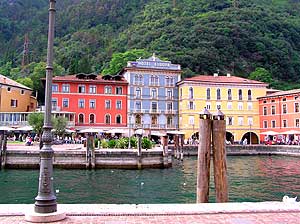

We are, also, prone to stay in towns we enjoy; so,
we were disappointed to find that all rooms were booked for the following evening.
We left the next morning in search of a place to stay somewhere on the eastern shore of the lake
and, just 15km south of Lago di Garda, we stopped at Malcesine. This turned out to be a
town that met not only all the expectations we had held regarding walking in an alpine setting
but also many of the things we love about Tuscany.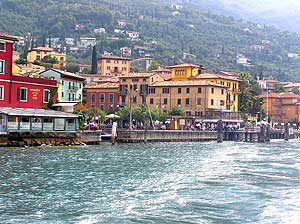
Malcesine enjoys a Mediterranean climate and lies among the fragrant olive and lemon groves of the lower slopes of Monte Baldo. (Olives harvested in this area are turned into an excellent extra virgin olive oil). Once a sleepy fishing village, it now bustles with life as cafes, bars, restaurants and shops line the narrow cobbled car-free streets that wind down to a picturesque harbour.
We went immediately to the hotel recommended in our
Lonely Planet. Albergo Aurora (Piazza
Matteotti 10) in the heart of the town and booked three nights. We walked down to the harbour,
finding it, indeed, picturesque and had lunch at one of the little outdoor cafes, looking out
at the lake; my gorgonzola pasta was one of the best I’ve tasted and George was happy too
as fresh fish was plentiful. We wandered the rest of the day, taking a disappointing tour of the
castle that, from a distance, looked intriguing but housed only remnants of a visit  made
by Goethe; otherwise it was a great day. That evening we went to a restaurant that had a patio
at the centre. It turned out to be George’s favourite (outside of Venice) on this trip;
so, we planned to return to it the next night.
made
by Goethe; otherwise it was a great day. That evening we went to a restaurant that had a patio
at the centre. It turned out to be George’s favourite (outside of Venice) on this trip;
so, we planned to return to it the next night.
Early the next morning we took the new revolving cable
car 2200m up Monte  Baldo
and enjoyed the views on the way up and down. At the summit the panoramas of Lago di Garda are
incredible. We hat realized that what we had found here was the alpine experience we had been
disappointed not to find when we were further north. The air was clear and a bit crisp; the sky
was blue; after walking for a half hour or so we stopped to watch a group of young parasailers
unpack (and unfurl) their colourful gear, run along the ground and eventually soar into the air,
reappearing around cliffs and over the lake; it made for a colourful scene. (Malcesine is especially
renowned for its breezes; so, attracts parasailers and windsurfers from around the world). We
walked along a trail that never ceased to offer spectacular views (in all directions), admired
the flowers and encountered more cattle (wandering freely with the bells around their necks signalling
their presence) than people.
Baldo
and enjoyed the views on the way up and down. At the summit the panoramas of Lago di Garda are
incredible. We hat realized that what we had found here was the alpine experience we had been
disappointed not to find when we were further north. The air was clear and a bit crisp; the sky
was blue; after walking for a half hour or so we stopped to watch a group of young parasailers
unpack (and unfurl) their colourful gear, run along the ground and eventually soar into the air,
reappearing around cliffs and over the lake; it made for a colourful scene. (Malcesine is especially
renowned for its breezes; so, attracts parasailers and windsurfers from around the world). We
walked along a trail that never ceased to offer spectacular views (in all directions), admired
the flowers and encountered more cattle (wandering freely with the bells around their necks signalling
their presence) than people.
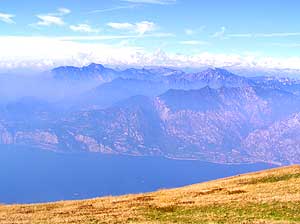

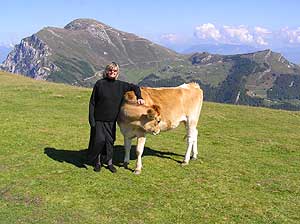

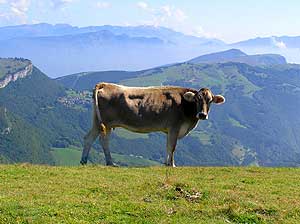
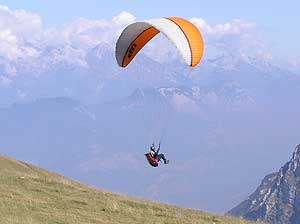
When we arrived back in Malcesine it was warm/hot;
so, we took a drive to explore further south along the lake, stopping briefly in the town of Garda
that we found to be too crowded and “touristy.” 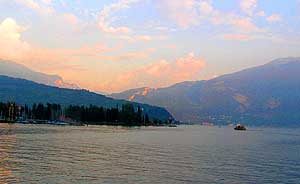 We
headed inland from there to Costermano, a pleasant agricultural village where, on the 6th of May
1967, the Cemetery for Fallen Germans was consecrated. Over the next 8 years, the bodies of 21,
920 fallen German soldiers, previously buried in various places in Northern Italy, were brought
here for dignified burial. An 8 meters high steel cross, visible from afar, rises from the highest
point. Walking from the parking lot to the entrance, we noticed the corn ready to be harvested
in the surrounding fields and the beautiful green rolling hills. There was a lone custodian in
the office adjacent to the entrance; he told us to walk through into the garden-like place where,
as far as we could see, there are tombstones of brown porphyr. On every grave, a tablet lists
the names, rank, age at and date of death of the two corpses inside. We walked through several
long rows of these crosses, tearfully noticing how very young these men were when they died. Heather
(dry but alive) was growing between the tombstones and there was only silence and solitude. We
realized that we were seeing only a very small portion of this gravesite that stood as a perpetual
monument to the tragedy of a war. We left, feeling a bit (irrationally) guilty that we had not
visited more of the graves and that we had not learned more than where they were born and where
they died about the people in those graves. (Throughout our time in Italy, and especially in the
north around Bolzano which was, of course, an area of extensive WWII fighting, bombing, destruction
and death) we had found ourselves frequently trying not to imagine what life had been like for
soldiers (and civilians) a little more than 60 years ago. Both of us just a bit too young to remember,
we had found it, in fact, increasingly difficult not to be thinking of that time).
We
headed inland from there to Costermano, a pleasant agricultural village where, on the 6th of May
1967, the Cemetery for Fallen Germans was consecrated. Over the next 8 years, the bodies of 21,
920 fallen German soldiers, previously buried in various places in Northern Italy, were brought
here for dignified burial. An 8 meters high steel cross, visible from afar, rises from the highest
point. Walking from the parking lot to the entrance, we noticed the corn ready to be harvested
in the surrounding fields and the beautiful green rolling hills. There was a lone custodian in
the office adjacent to the entrance; he told us to walk through into the garden-like place where,
as far as we could see, there are tombstones of brown porphyr. On every grave, a tablet lists
the names, rank, age at and date of death of the two corpses inside. We walked through several
long rows of these crosses, tearfully noticing how very young these men were when they died. Heather
(dry but alive) was growing between the tombstones and there was only silence and solitude. We
realized that we were seeing only a very small portion of this gravesite that stood as a perpetual
monument to the tragedy of a war. We left, feeling a bit (irrationally) guilty that we had not
visited more of the graves and that we had not learned more than where they were born and where
they died about the people in those graves. (Throughout our time in Italy, and especially in the
north around Bolzano which was, of course, an area of extensive WWII fighting, bombing, destruction
and death) we had found ourselves frequently trying not to imagine what life had been like for
soldiers (and civilians) a little more than 60 years ago. Both of us just a bit too young to remember,
we had found it, in fact, increasingly difficult not to be thinking of that time).
That evening at dinner the same group of young people
we had watched soar into the air that morning were seated at the table next to us; so, it seems
they all landed safely.
The next day we took one of the ferries across the lake to the town of Limone – one of those
picturesque tourist towns that is a little too pretty and very much too crowded. We walked past
the centre of town and found a lovely restaurant overlooking the lake, had a great lunch, took
pictures of pomegranates and caught the ferry back “home” to Malcesine.
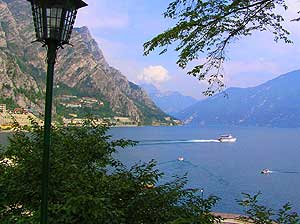
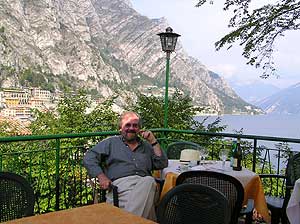

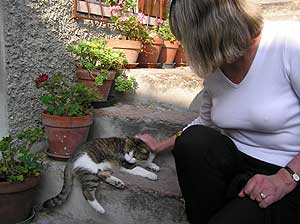
That evening we walked along the shore,
beyond the town, and looked back to observe how lovely it was; we watched the sunset and had a late dinner in the restaurant down
by the harbour where we had enjoyed lunch the first day. It was, we agreed, the kind of place
one might choose for a restful holiday – one much longer than the few days we had spent
there. (It’s not surprising to us that Lago di Garda has attracted writers – people
like D. H. Lawrence who completed Sons and Lovers there and whose collection of essays: Twilight
in Italy (which I am reading now) is a reflection on his experience of living there from the autumn
of 1912 to the spring of 1913;
to observe how lovely it was; we watched the sunset and had a late dinner in the restaurant down
by the harbour where we had enjoyed lunch the first day. It was, we agreed, the kind of place
one might choose for a restful holiday – one much longer than the few days we had spent
there. (It’s not surprising to us that Lago di Garda has attracted writers – people
like D. H. Lawrence who completed Sons and Lovers there and whose collection of essays: Twilight
in Italy (which I am reading now) is a reflection on his experience of living there from the autumn
of 1912 to the spring of 1913;  Thomas
Mann, Nietzsche and Kafka were drawn to Riva del Garda; Goethe, in 1786, started his voyage through
Italy at Lago di Garda and was so struck by the beauty of Malcesine (and its castle) that he drew
a sketch.
Thomas
Mann, Nietzsche and Kafka were drawn to Riva del Garda; Goethe, in 1786, started his voyage through
Italy at Lago di Garda and was so struck by the beauty of Malcesine (and its castle) that he drew
a sketch.
Leaving we felt was a mistake but we had just a couple of days left and were near Verona which our guide book described as too charming to miss; so, we said good bye to our hosts who insisted on giving us a poster of the town and a bottle of Chardonnay Valdadige (Al Molino, Verona, 2004) and told us that they would be closing soon for the season to concentrate on their other family business – the making of olive oil.
Reluctantly, we headed for Verona. And quickly (but
unfortunately not before booking a hotel room for the night in Verona) we admitted to each other
that we had, indeed, made a mistake.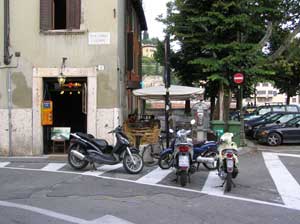 What, I think, captures our experience best (aside from the pictures of the cars and motorcycles
that were everywhere) is the visit we made to the balcony of Juliet’s home – yes the
'real' balcony of the fictional Shakespearean Romeo & Juliet that has come to be Verona’s
claim to fame.
What, I think, captures our experience best (aside from the pictures of the cars and motorcycles
that were everywhere) is the visit we made to the balcony of Juliet’s home – yes the
'real' balcony of the fictional Shakespearean Romeo & Juliet that has come to be Verona’s
claim to fame.
A sign that says that it is illegal to write on the walls, is attached to a wall covered in scrawling
and filthy graffiti which is supposed to bring the writers love and happiness. Nearby pairs of
tourists stood behind the statue of Juliet with their hands clasped over her breasts, again for
good luck. On the balcony, several Japanese tourists were smiling as someone below took their
pictures.
We hated Verona - its filth and phoniness - so very
early the next morning, we escaped for the Eugean Hills. We stopped in Monselice and decided that
we liked it well enough to stay there for our last night but thought that we 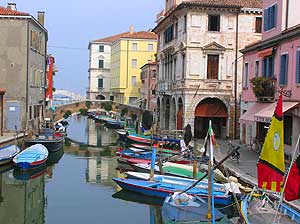 should
first take a look at Chioggia, one of Italy's major fishing ports that lies at the southern
end of the Venetian lagoon. We had a pleasant lunch there but found that, aside from a very small
area that had an old Venetian feel to it, Chioggia was primarily a suburban looking sprawl of
modern hotels.
should
first take a look at Chioggia, one of Italy's major fishing ports that lies at the southern
end of the Venetian lagoon. We had a pleasant lunch there but found that, aside from a very small
area that had an old Venetian feel to it, Chioggia was primarily a suburban looking sprawl of
modern hotels.
We returned to Monselice (from the Latin “toponim Mons Silicis” meaning mountain
of flintstone), a town located in North-East Italy, in the Veneto region, province of Padua (Padova).
It turned out to be a small (pop 17,000), sleepy village (almost entirely devoid of tourists)
that had an ancient, local feel and some interesting historical features. Once wrapped in five
protective layers of fortification, the town centre, whose buildings date from the 15th and 17th
centuries, is nicely restored.
We took a guided tour of the Castello, an imposing fortress
dating from the late middle ages with extensions dating from later times. Transformed into a residence,
it took on its current appearance at the end of the 1400s. In 1942, it was converted into a museum
and now houses a rich collection of arms, furnishings and memorabilia bought up cheaply during
WWII. There were only two couples on this tour; the other couple spoke only German. Our tour guide,
a local girl whose native language was Italian, spoke English and German so fluently that she
managed, with remarkable ease, to conduct the tour in both languages, often shifting mid sentence.
Many aspects of that tour were intriguing, both because for our guide this history was local and
animated by family history and personal meaning and because it gave such a sense of what life
was like at various historical times. 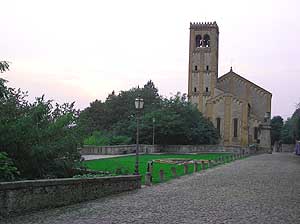 The
most ancient part – the kitchen - dating from the middle ages opened out on a garden, the
whole scene so authentic (and real) that it gave us the feel that we had somehow travelled back
in time.
The
most ancient part – the kitchen - dating from the middle ages opened out on a garden, the
whole scene so authentic (and real) that it gave us the feel that we had somehow travelled back
in time.
We had that same feeling when we walked (absolutely alone and in silence) further up the hill
and through the Porta Romana (the Roman or Holy door), erected in 1651, to mark the entry to the
sanctified area of the Santuario Guibilare delle Sette Chiese (Jubilee Sanctuary of the Seven
Churches). A 1605 papal bull grants this sanctuary the same indulgences given the faithful during
pilgrimages to the seven major basilicas in Rome. Looking into each of these small stone chapels
we could see an altar piece – also of stone from the workshop of Palma the Younger. At the
top, aside from a magnificent view back onto the village are some remarkable ancient structures,
such as the small church that now houses the Christian martyr St. Valentine transferred here from
the Roman catacombs in the mid 1600s. This village, not surprisingly honours him on February 14.
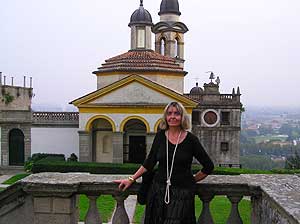
That evening our search for a restaurant proved difficult. We did eventually find a somewhat basic
(rustic) pizza place that was so quiet that we had our choice of tables, We sat near the oven
so that we could watch the occasional pizza being made and the pleasant owner was kind enough
to open the shutters so that we could look up onto the hill where St. Valentine rests.
The next day was our last day but we awoke looking forward to having the whole day because we
didn’t have to be back at the airport till 7pm flight. We set out in search of the perfect
last Italian meal which, mistakenly, we expected to find in the Eugean Hills; we had been told
that there were little places doing their culinary magic everywhere in these hills. Every one
of these little places we managed to find was closed (either for that day or for the season).
So, we drove into the town of Petrarca, a village famous because, in the 1300s, it was the home
of Petrarch. But there was no restaurant (open) to be found and, as it turned out, Petrarch’s
house, which is now a tourist destination, was closed for tours until the late afternoon. We left
and, getting hungrier and hungrier, finally turned off the road into a spa town (Abano de Terme),
stopped at a pizzeria on a busy corner and, looking across at a funeral shop and reading signs
about upcoming burials, “enjoyed” our last lunch on this trip to Italy. It was a very
hot day and we found ourselves thankful that we were not angry with each other for how this last
day in Italy had turned out and wanting only to get home. 35 hours (with one night layover at
our B&B in Gatwick) we were happily home.